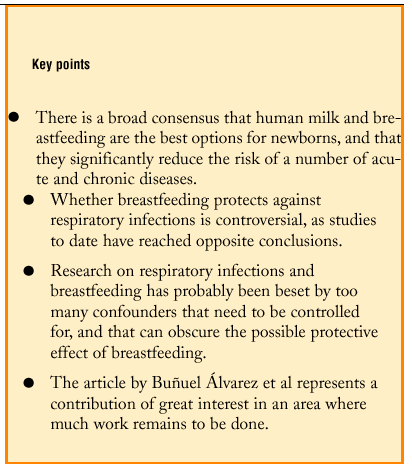esearch efforts aimed at demonstrating the benefits of human milk in our species continue to be important, and studies constantly report new discoveries of the potential health benefits of breastfeeding.1 There is widespread consensus among specialists in this area of research that human milk and breastfeeding are the best options for favoring growth and development in newborns, and that breastfeeding significantly decreases the risk of a number of acute and chronic diseases.2,3 Specifically, the beneficial effects of breastfeeding in reducing the incidence and severity of infectious diseases have been documented for acute gastroenteritis, respiratory infections, otitis media, bacteremia, bacterial meningitis, urinary tract infection and botulism.
Despite the constant improvements that the infant food industry has incorporated into formulas for artificial feeding, baby formulas are still far from similar to human milk. However, this does not mean that the differences are easy to measure, or that significant differences in the beneficial effects of breastfeeding can be shown for certain variables. It is not hard to understand why findings that favor breastfeeding may not become evident in certain settings (eg, in industrialized countries, if what is being measured is the decrease in mortality). Nevertheless, in other settings deficient health and environmental conditions can reveal differences between breastfeeding and artificial feeding in terms of mortality due to acute gastroenteritis.4
The study by Buñuel Álvarez et al5 in this issue of Atención Primaria is of great interest because these authors investigated the relationship between type of infant feeding during the first 6 months of life and the incidence of respiratory tract infections during the first 12 months in a population of Spanish infants. They controlled for a number of other variables (day care attendance, familial antecedents of atopic disorders, parents´ smoking habit and level of education, and number of persons in the household) that can influence these infections and that many studies have found to act as confounders. The main conclusions are that breastfeeding, in comparison to artificial feeding, has no protective effect on the incidence of upper or lower respiratory tract infection during the first year of life, whereas other variables such as the number of persons in the household, familial antecedents of atopy and day care use are related with a higher incidence of lower respiratory tract infections.
The merit of this study, carried out in primary care centers in Spain, is twofold: this is the first study of its type to use appropriate methods to investigate this complex hypothesis, and it is the first to provide evidence of a lack of any protective effect of breastfeeding on respiratory infections in the reference population.
Whether breastfeeding confers any protection against respiratory infections is a highly controversial topic, and published studies have reached opposite conclusions.6,7 Several explanations have been offered for these differences: methodological problems have been noted in some studies, while other analyses have claimed that the protection afforded by breastfeeding against respiratory infections is limited to industrialized countries. The most important issues that need to be faced in future studies that set out to resolve the controversy are appropriate control for possible confounding variables, use of a long-term prospective design, appropriate definition of the type of respiratory infection to be studied, and a sample size large enough to analyze the protective effect of prolonged breastfeeding in the absence of any other type of feeding in populations where the prevalence of prolonged breastfeeding exclusive of other types of infant feeding is low.
Research on respiratory infections and breastfeeding has probably been beset by too many confounders that need to be controlled for, and that can obscure the possible protective effect of breastfeeding. How the variable «respiratory infection» is defined is also important, as upper airway infections are of less concern than lower airway infections--although it can be difficult to distinguish one from the other. The advantages of using a prospective design are obvious. In conclusion, the article by Buñuel Álvarez et al is of great interest in an area where much work remains to be done. Regrettably, pitfalls in the design of these studies and the lack of financial support to perform them will keep us from obtaining, at least in the near future, the answer to a question we should all be asking: how much protection does prolonged breastfeeding exclusive of other types of feeding provide against respiratory infections in countries with well developed health care systems?









